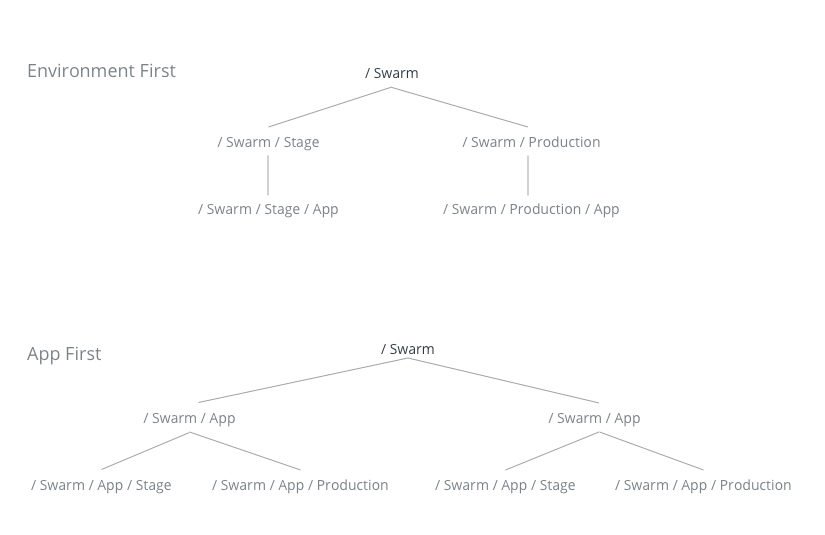Group and isolate cluster resources
Group and isolate cluster resources¶
Docker EE enables access control to cluster resources by grouping resources into resource sets. Combine resource sets with grants to give users permission to access specific cluster resources.
A resource set can be:
- A Kubernetes namespace for Kubernetes workloads.
- A UCP collection for Swarm workloads.
Kubernetes namespaces¶
A namespace allows you to group resources like Pods, Deployments, Services, or any other Kubernetes-specific resources. You can then enforce RBAC policies and resource quotas for the namespace.
Each Kubernetes resources can only be in one namespace, and namespaces cannot be nested inside one another.
Swarm collections¶
A Swarm collection is a directory of cluster resources like nodes, services, volumes, or other Swarm-specific resources.
Each Swarm resource can only be in one collection at a time, but collections can be nested inside one another, to create hierarchies.
Nested collections¶
You can nest collections inside one another. If a user is granted
permissions for one collection, they’ll have permissions for its child
collections, pretty much like a directory structure. As of UCP 3.1,
the ability to create a nested collection of more than 2 layers deep
within the root /Swarm/ collection has been deprecated.
The following image provides two examples of nested collections with the recommended maximum of two nesting layers. The first example illustrates an environment-oriented collection, and the second example illustrates an application-oriented collection.

For a child collection, or for a user who belongs to more than one team, the system concatenates permissions from multiple roles into an “effective role” for the user, which specifies the operations that are allowed against the target.
Built-in collections¶
Docker EE provides a number of built-in collections.
| Default Collection | Description |
|---|---|
/ |
Path to all resources in the Swarm cluster. Resources not in a collection are put here. |
/System |
Path to UCP managers, DTR nodes, and UCP/DTR system services. By default, only admins have access, but this is configurable. |
/Shared |
Default path to all worker nodes for scheduling. In Docker EE Standard, all worker nodes are located here. In Docker EE Advanced<https://www.docker.com/enterprise-edition>, worker nodes can be moved and [isolated](isolate-nodes.md). |
/Shared/Private |
Path to a user’s private collection. Note that private collections are not created until the user logs in for the first time. |
/Shared/Legacy |
Path to the access control labels of legacy versions (UCP 2.1 and lower). |
Default collections¶
Each user has a default collection which can be changed in UCP preferences.
Users can’t deploy a resource without a collection. When a user deploys a resource without an access label, Docker EE automatically places the resource in the user’s default collection.
With Docker Compose, the system applies default collection labels across
all resources in the stack unless com.docker.ucp.access.label has
been explicitly set.
Default collections and collection labels
Default collections are good for users who work only on a well-defined slice of the system, as well as users who deploy stacks and don’t want to edit the contents of their compose files. A user with more versatile roles in the system, such as an administrator, might find it better to set custom labels for each resource.
Collections and labels¶
Resources are marked as being in a collection by using labels. Some resource types don’t have editable labels, so you can’t move them across collections.
Note
- Can edit labels: services, nodes, secrets, and configs
- Cannot edit labels: containers, networks, and volumes
For editable resources, you can change the
com.docker.ucp.access.label to move resources to different
collections. For example, you may need deploy resources to a collection
other than your default collection.
The system uses the additional labels, com.docker.ucp.collection.*,
to enable efficient resource lookups. By default, nodes have the
com.docker.ucp.collection.root,
com.docker.ucp.collection.shared, and
com.docker.ucp.collection.swarm labels set to true. UCP
automatically controls these labels, and you don’t need to manage them.
Collections get generic default names, but you can give them meaningful names, like “Dev”, “Test”, and “Prod”.
A stack is a group of resources identified by a label. You can place
the stack’s resources in multiple collections. Resources are placed in
the user’s default collection unless you specify an explicit
com.docker.ucp.access.label within the stack/compose file.